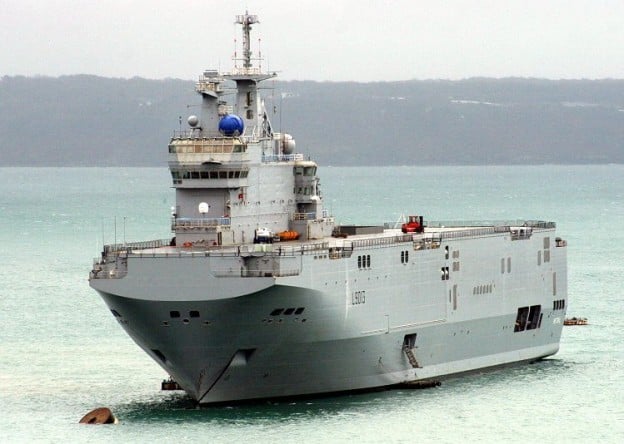
One of the most significant decisions of Russia’s now-disgraced and soon-to-be-indicted former minister of defense Anatoly Serdyukov was the decision to procure Mistral–class helicopter carriers from the French. That was a radical departure from previous Soviet/Russian doctrine, which demanded that the country be able to produce all its own weapons systems. The total reliance on domestic suppliers was seen as a way to ensure the country’s sovereignty: the Russians thought that dependence, or even potential dependence on any external supplier would place major constraints on their decision-making. When one sees how the United States is able to comprehensively influence the foreign and defense policies of countries that rely on its military hardware, the Russian position does not seem without merit or logic.
There have recently been reports that delivery of the first Mistral–class ship is being delayed because the stern section—being built by Severnaya Verg shipyard in St. Petersburg—has experienced significant problems. Those reports were immediately and vehemently contested by Dmitry Rogozin, a blustering former ambassador to NATO who has taken charge of the implementation of the 2020 weapons procurement program, who assured a number of Russian media outlets that the project was on schedule.
However, even if by some miracle the Mistrals are constructed on time, the recent uproar throws into stark relief just how much of an outlier they are. Rather than ushering in a bold new era of Russian procurement practices, the Mistrals look increasingly like a one-off experiment. When the deal was first announced at the end of 2010, four Mistrals were involved: two to be built in France and two, at a later date in Russia. The Russians, however, are backing away from that stance, recently reminding everyone that the “firm contract” is only for two ships and that it would be “unreasonable” to procure any additional vessels until the first two have been delivered and put through their paces.
The purchase of the Mistrals was supposed to serve two purposes simultaneously. First it would supply Russia with state-of-the-art warships that could serve a function its fleet had been unable to perform. Second, it would put the Military Industrial Complex (MIC) on notice that the rules had changed and that if it could not meet the needs of the armed forces then other suppliers—foreign—would be used. Encouraging greater efficiency in the MIC was seen as particularly important because of the ambitious 2020 rearmament program, in which hundreds of billions of dollars would be spent acquiring up-to-date hardware.
The problem is that Serdyukov’s threat to the MIC was never a realistic one. Virtually the entire Russian General Staff agreed with the “domestic only” doctrine, and did what they could to undermine efforts to buy weapons abroad. Additionally, the MIC itself was too politically well-connected to take seriously the threat that the Defense Ministry would take its business abroad. Putin himself is ever more reliant on the support of blue-collar workers, such as those who man the MIC, and the Kremlin simply will not take the risk of shuttering any more factories or of “offshoring” the defense industry.
While a “100 percent domestic” policy might have worked for the Soviet Union, a country which devoted such a mind-boggling percentage of its GDP to defense that even the best estimates of military spending have a margin of error of 1-2 percent of total economic output, it is much more difficult for a country like the Russian Federation. Russia, despite a lot of bluster and saber-rattling, spends roughly the same percentage of GDP on the military as the United States. Given the small size of Russia’s economy in comparison with that of the United States, that makes a complete reliance on domestic suppliers a very difficult proposition. That is particularly true when taking into account the still parlous state of Russia’s defense industry and, in particular, the disastrous state of many suppliers and sub-contractors.
So while we will simply have to wait and see the extent to which the delivery of the first Mistral is actually delayed, we can already see that Russia is retreating from the bold procurement reforms that were initially proposed by Serdyukov. Sergei Shoigu, the current minister of defense and one of Russia’s most popular politicians, has made every effort to undo the reforms instituted by his predecessor, and all indications are that, when it comes to naval weaponry, Russia will once again operate on the assumption that it needs to create all of its own systems.
Considering the chaotic state of Russia’s shipbuilding industry, demonstrated most dramatically by the repeated and increasingly comical delays of the Indian aircraft carrier Vikramaditya, the end of any flirtation with foreign acquisitions suggests that Russia’s much-touted rearmament program will remain more fiction than fact. There was a small, fleeting chance that Russia would rejuvenate its moribund defense industry with a large-scale infusion of foreign expertise and technical know-how, but that option now appears to be off the table. So even if the Mistrals show up on time, expect virtually every other part of the rearmament campaign to experience the same chronic delays that have plagued it since inception.





